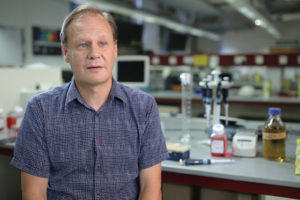Autosomal analog of X-chromosome inactivation
Assistant Professor at Harvard University Alexander Gimelbrant on epigenetic regulation, olfactory receptors, ...
What are the limits of life? How can some living creatures survive in extreme environments? What conditions does a planet have to comply with to be suitable for life? These and other questions are answered by Research Scientist at Massachusetts Institute of Technology Christopher Carr.
Our notion of life’s limits has evolved greatly since we had learnt about the structure of DNA and since the 70’s when this entire branch of life – the Archaea, this new domain – was discovered. The Archaea, as a whole, were first identified in very extreme environments, but later found to be relatively ubiquitous and one of their unique characteristics is adaptation to chronic energy stress. Relating this back to not just archaea, but archaea and bacteria, and even eukaryotes like ourselves, there are many organisms that have really adapted to extremely low energy flux and to extremely low nutrient supply.
So our notion of habitability has really expanded with the advent of molecular approaches to search for and characterize life. This is because most life is not culturable. But with these molecular tools we would be able to say, “Oh, there is definitely life out there!” We are not yet sure what it’s doing or how it’s doing it, but now we are able to discover that and relate it to its environment, what nutrients are available, and what are the limits on the activity in these environments.
Let me talk about a particular kind of adaptability and that is the environmental metagenomics work that we are doing, we are studying terrestrial analogues of Mars. And in particular, one of the areas we are studying is an acid hydrothermal system on the flank of a volcano Copahue, an active volcano in the Andes mountains. One of the questions in our mind is how is this environment being colonized? There are periodic volcanic eruptions, but how would life, say, on the early Earth or two billion years ago colonize these environments?
In, I believe, 2013, there was a paper demonstrating transport of some large organisms, diatoms, which might be from ten to a hundred microns, by a volcanic eruption, by a phreatic eruption, in which, basically, magma is coming into contact with water and producing explosive events. The authors believe that these diatoms can be transported up to 800 kilometers or more and potentially in a viable state. And so one of the questions that I am working on now is could smaller organisms be transported even further distances? Could this happen in a way that organisms could be transported near or even globally on Earth? And that may have helped these microbes that are colonizing these specific extreme niches in, say, very acidic environments or volcanic environments spreading from place to place.
We are going to try to test it empirically through comparative genomics of these different environments and trying to understand if there is a spatial relationship between their genomes, but also potentially sampling the atmosphere. That relates to another area which is what microbes are being transported in the air and are they active or viable? Microbes have had an association with the atmosphere for billions of years. On the early Earth there may not have been much continental crust and Earth was covered in the ocean largely, if not completely.
Once the early continents began to form, microbes began to weather the continental crust.
And weather away metals like iron sulfide minerals or other materials that were available, and this material would end up in the ocean.
Microbes would have to get from habitable environment to habitable environment. So what we are studying today might have implications for how this weathering process took place 2.5 billion years ago. It was during this time when photosynthetically produced oxygen was beginning to build up, and Earth was shifting from an environment with little to no oxygen to 20% oxygen. So in that context, for microbes on the early Earth, this transition of oxidation – the Great Oxidation event, as it is called, that happened about 2.4 or 2.5 billion years ago – was truly extreme. It was one of the great catastrophes in the history of life on Earth. In that context, today’s environment is very extreme for many microbes. Those microbes today either adapted to this extreme oxygen level or found environments where there was not a lot of oxygen. And so that is why, for example, we might find those microbes in the subsurface of the ocean, but they could also be in the human gut.
So there are limits on adaptation, but we really do not know what they are right now. We are really continuing to explore that with genetic tools that do not require us to culture organisms. It is very hard to guess whether there are all the factors that are required to grow a given organism – there may be many signals that we cannot provide in a lab or simply do not know how to provide at the moment.
Our notion of what environment is habitable has been expanding. It generally does not contract, because whether we find a natural microbe or whether we evolve a microbe that can adapt to a particular environment – once we have done it, it is an existence proof that life, in fact, can tolerate that extreme condition.
Let us take an example. We used to think that 100°C might have been an upper limit for life as we know it, but then organisms were discovered at hydrothermal vents that were capable of temperatures even up to 120°C.
Over time, our notion of what are the limits has greatly expanded.
And I suspect that as we continue exploring the natural world – like undersea vent, high altitude microbes, low pressure if we are simulating Mars in the lab, high temperatures, perhaps, in industrial applications or extreme concentrations of particular materials – we will further expand our notion of what is a habitable environment. This has really deep implications for the extent to which life is coming in the Universe, because we are now discovering many, many extrasolar planets and we are going to start learning about what kinds of planets these might be.
If we consider what might be a habitable planet and our notion of habitable planets is “does it have a liquid water on the surface?”, “does it look like the Earth?”, etc., this may be a really poor basis for evaluating what is the quantity and quality of habitability in the Universe. Now we know that life can survive 4 kilometers into the crust, we are starting to get a notion of environments like sea floor vents, say, an alkaline vent. Probably the most plausible case for the origin of life would be at an alkaline vent within an acidic ocean.
We now know there are subsurface oceans on Europa and Enceladus and maybe in other places in our own solar system, let alone habitable worlds in other star systems which may not look like Earth, but may have subsurface environments that are very similar to Earth. In that context, it may dramatically expand our notion of habitability. If we were to find life beyond Earth, say, somewhere else in the solar system, that could help us have an existence proof, particularly if it is not related to life on Earth, that life is likely to be common in the Universe. I think that is a key notion. We are expanding our notions of habitability, and once we have more than an n of one, we will have a sense of how common life is in the Universe.

Assistant Professor at Harvard University Alexander Gimelbrant on epigenetic regulation, olfactory receptors, ...

Molecular biologist Greg Towers on the immunodeficiency virus, the Red Queen effect, and the role of retroviru...

Truth and myths about the structure and functioning of immunity